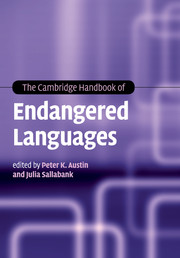Book contents
- The Cambridge Handbook of Endangered Languages
- Series page
- The Cambridge Handbook of Endangered Languages
- Copyright page
- Contents
- Figures
- Tables
- Contributors
- Acknowledgements
- 1 Introduction
- Part 1 Endangered languages
- Part II Language documentation
- 9 Language documentation
- 10 Speakers and language documentation
- 11 Data and language documentation
- 12 Archiving and language documentation
- 13 Digital archiving
- Part III Responses
- Part IV Challenges
- References
- Index of language names
- Index
9 - Language documentation
from Part II - Language documentation
Published online by Cambridge University Press: 05 June 2012
- The Cambridge Handbook of Endangered Languages
- Series page
- The Cambridge Handbook of Endangered Languages
- Copyright page
- Contents
- Figures
- Tables
- Contributors
- Acknowledgements
- 1 Introduction
- Part 1 Endangered languages
- Part II Language documentation
- 9 Language documentation
- 10 Speakers and language documentation
- 11 Data and language documentation
- 12 Archiving and language documentation
- 13 Digital archiving
- Part III Responses
- Part IV Challenges
- References
- Index of language names
- Index
Summary
- Type
- Chapter
- Information
- The Cambridge Handbook of Endangered Languages , pp. 159 - 186Publisher: Cambridge University PressPrint publication year: 2011
- 37
- Cited by



